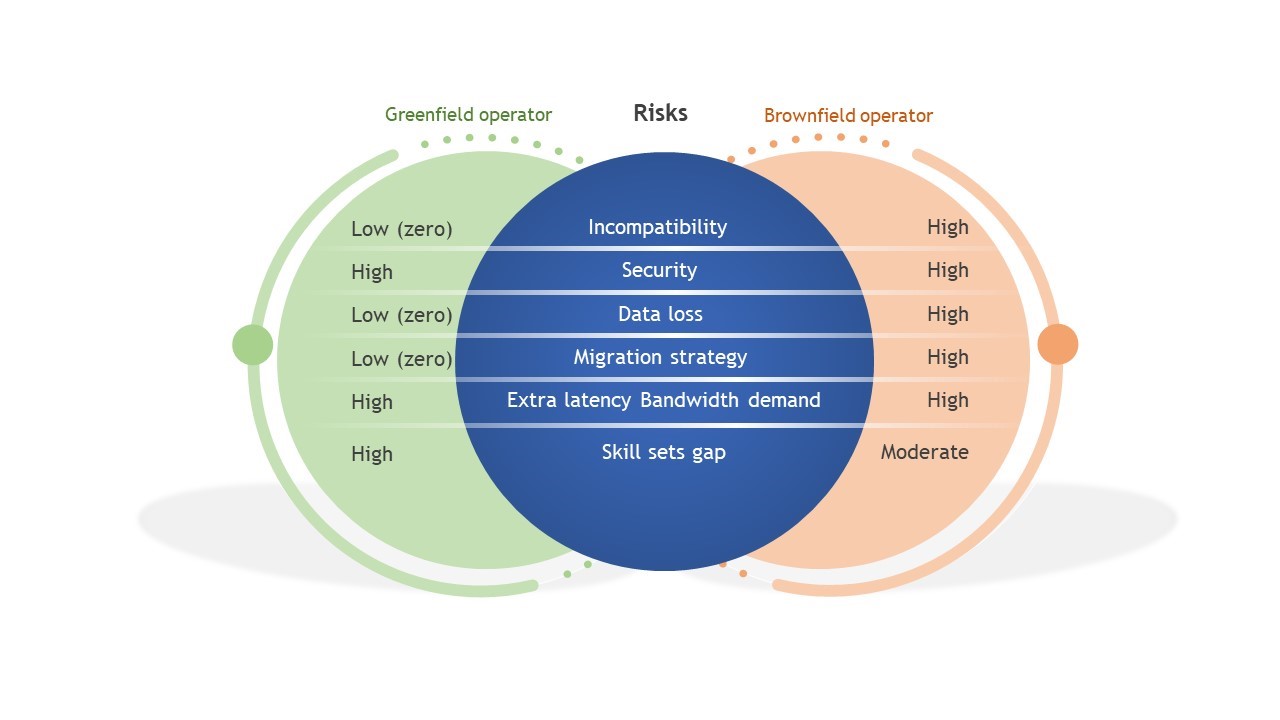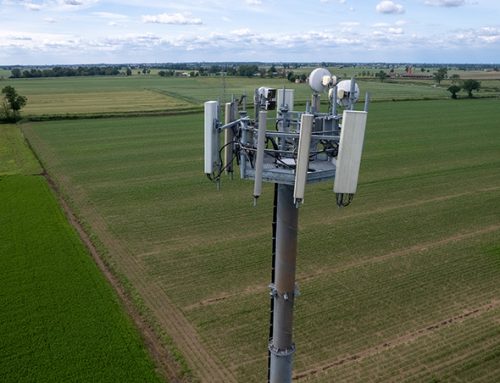There are always risks involved when organizations start the widespread adoption of cloud computing. A lack of risk management can cause unexpected delays and cost overruns. Naturally, cost optimization becomes a huge part of risk management for communications service providers (CSPs) about to (or already have) started their telco cloud migration journey.
The allure of numerous benefits cloud migration brings often leads to a fervent pursuit of high-value cloud adoptions, overshadowing critical risks, taking big bite out of the cloud migration budget. This impedes the cloud transformation process.
However, substantial risks can be successfully mitigated through comprehensive due diligence and meticulous planning. In this blog, we present distinct factors that could result in overspending time and money and list steps to avoid an unexpected bill at the end of the telco cloud transformation exercise.
Cloud Management Risks that Cost Telcos
Potential risk #1 – Incompatibility with current infrastructure
Incompatibility of existing architecture reduces the execution speed of migration. The existing network elements (usually sourced from multiple OEMs) have variable response speeds, slowing down the cloud migration process.
A lack of governance policy before migrating the workloads usually leads to loss in performance and presents challenges in managing cost and security. For this reason, due diligence is required to check technical debts that arise from interdependencies between network elements and processes and even interoperability inconsistencies.
Everyone knows that data is most vulnerable during migration. Cloud data transfer introduces new external attacks, insider threats, malware, insecure APIs, and compliance risks. Data can be lost, exposed, or maliciously encrypted (ransomware).
Organizations with traditional security products and flat budgets are no longer enough to meet cloud security needs. Telcos that can’t obtain additional budget will need to move around costs and focus on their security budget to respond to cloud-specific cybersecurity threats and ensure compliance with industry regulations.
Potential risk #2 – Security
Everyone knows that data is most vulnerable during migration. Cloud data transfer introduces new external attacks, insider threats, malware, insecure APIs, and compliance risks. Data can be lost, exposed, or maliciously encrypted (ransomware).
Organizations with traditional security products and flat budgets are no longer enough to meet cloud security needs. Telcos that can’t obtain additional budget will need to move around costs and focus on their security budget to respond to cloud-specific cybersecurity threats and ensure compliance with industry regulations.
Potential risk #3 – Data loss
The cloud migration process can reveal inconsistencies that pose a risk of data loss. Such inconsistencies can occur migration, whether from data file corruption or missed table in data replication or duplicated data points.
Determining the cost of lost data can be a complicated process that relies on multiple factors, including decreased productivity, response expenses, penalties and regulatory expenses, and damage to reputation. Moreover, the type of information lost, and its corresponding value also significantly impacts the total cost of the data loss.
Potential risk #4 – Incorrect migration planning
Insufficient due diligence and planning before migrating to the cloud can lead to a lack of clear understanding regarding what to migrate and what to keep on-premises. This can result in sensitive data and applications being impacted during the migration process.
Additionally, choosing an incorrect migration approach, such as lift and shift or rearchitecting, can lead to increased migration time, costs, and reduced productivity.
Potential risk #5 – Extra latency and bandwidth demand
Organizations often underestimate the bandwidth needed for migrating workloads to the cloud. There is a point during the cloud migration process, where data or services will co-exist on-premises and the cloud. At this moment, ample bandwidth is needed for seamless communication between the services. Without enough bandwidth, latency issues will creep in and continue to grow, resulting for less-than-ideal customer experience and increased customer supports costs.
Potential risk #6 – Skill sets gap
Moving to cloud-based platforms requires a shift towards digital technology. For instance, DevOps practices and automation, which can be unfamiliar to traditional telecom teams. Organizations often underestimate the negative impact of cloud skills shortage. Inefficiencies such as sub-optimal architecture, improper migration, and significant delays cause companies to spend more than planned.
These risks can have different impacts across greenfield and brownfield operators based on various factors such as operator ageing, IT availability, network infrastructure and customer base.

Telco cloud migration risks – Greenfield vs. Brownfield Operator
| Risks | Greenfield operator | Brownfield operator |
|---|---|---|
| Incompatibility | Low (zero) | High |
| Security | High | High |
| Data loss | Low (zero) | High |
| Migration strategy | Low (zero) | High |
| Extra latency/Bandwidth demand | High | High |
| Skill sets gap | High | Moderate |
Planning and budgeting telco cloud migration
As is observed in various reports, it is challenging to estimate costs even with specific strategies on paper. Having a detailed view of all possible factors are crucial to estimate and manage migration costs more effectively. Below are various cost factors involved in cloud migration:
Pre migration costs
Pre-migration costs mainly consist of infrastructure costs along with a few indirect costs.
- IT Infrastructure costs: The IT infrastructure costs will depend on the upgrades required for various applications and underlying hardware, considering their interconnections with the cloud infrastructure. The cost will be lower for a less complex infrastructure, but a larger infrastructure will require more manpower and more upgrades.
- Cloud infrastructure costs: The cost includes application components, hardware (storage and compute), and network interconnection devices (e.g., switches, routers, bridges, repeaters, and gateways).
- Indirect costs: These are less obvious (and often ignored) expenses related to lost productivity due to application downtime and outages.
Migration costs
The cost for a cloud migration project can be broken down into two main categories
- Execution costs (data movement and integration): It includes application and database integrations, data centre migrations, data migration tools and strategies, and the actual implementation of the migration (such as containerization, instances right sizing, and detailed testing).
- Consultation fees: The second category is consultation fees, which include the cost of creating a Centre of Excellence (COE), overall project management for the cloud migration, reorienting team and processes, and skill development required for the migration activity.
Post migration costs
These costs are O&M and management costs post cloud migration for all applications.
- Cloud hardware, application licensing costs: These include the annual costs of cloud hardware AMC and application licensing, which are determined based on the amount of computing power and storage space used. These costs are typically straightforward and quoted directly by cloud providers.
- Training costs: Another factor to consider is the cost of skill development. With the rapid pace of technological advancement, it is important to ensure that existing resources are upskilled to ensure they can operate, manage, and troubleshoot the cloud environment effectively.
- Monitoring and maintenance: Finally, this includes the cost of manpower, as well as the various tools and processes involved in monitoring and maintaining the cloud environment.
| Budget Factors | Cost distribution (Greenfield operator) | Cost distribution (Brownfield operator) | ||
|---|---|---|---|---|
| Factor | Percentage | Factor | Percentage | |
| Network Upgrade Infrastructure costs | Nil | 0% | Low | 15% |
| Cloud Infrastructure Costs | High | 60% | High | 25% |
| Indirect Costs pre migration | Nil | 0% | High | 2% |
| Migration Costs | Nil | 0% | High | 30% |
| Indirect Costs Fees | Nil | 0% | Low | 3% |
| AMC and subscription Costs | High | 10% | High | 10% |
| Skill Development | High | 15% | Low | 5% |
| Monitoring and maintenance | High | 15% | Low | 10% |
Getting it right: Budget vs. risk
- Assess needs and goals
To manage the cost and risk of cloud migration, start by assessing the business goals and current infrastructure. Follow the outperformers that have shown what it takes to avoid costly hurdles during cloud-migration. The bigger and older the telco organization is, the more complex the application and data migration process. Going 100% cloud may not be a good idea. A hybrid cloud environment would make more sense. - Choose the correct cloud model and migration partner
Determine the cloud service models – IaaS, PaaS or SaaS – that match the organization’s specific needs. These service models aren’t mutually exclusive. Large telcos often use all three to take advantage of features specific to each of these cloud models.
The telco environment can be extremely complex and a cookie-cutter approach to cloud migration won’t guarantee success. A migration partner with extensive experience and deep telco vertical expertise understands the challenges in moving applications to the cloud.
A technology partner that provides end-to-end solution, from advisory and implementation to managed services, will augment value across all stages of the telco cloud migration journey. - Choose the correct migration and deployment strategy
Select the most appropriate migration strategy based on the current infrastructure, the complexity of the workloads, and the costs involved. Most telcos have two options to choose from – the lift and shift mechanism or the more comprehensive rearchitect mechanism. The “lift and shift” approach is the fastest and easiest, but it is also the riskiest and involves higher indirect cost.
On the other hand, rearchitecting is complex and involves high pre-migration costs. Therefore, depending on the organization’s impact tolerance, a hybrid strategy may help. - Implement cloud migration practices and tools
To ensure a seamless migration process, it’s crucial to analyse the current inventory, applications, data, and processes to identify any dependencies, risks, or issues that could affect migration. Additionally, telcos need to develop a detailed plan, RASCI, and process definitions for migration. Use migration tools to automate and streamline data transfer. Thorough testing before and after migration can also reduce the risks of migration failures. - Workload Management
Mitigating security risks in paramount for protecting workloads. It is crucial to appoint a reliable partner to deploy security-trained resources, and implement specific measures in the network, such as multi-factor authentication, data encryption during migration, user access policies, VPN connection, firewall configurations.
Additionally, it is necessary to back up the workloads regularly to for data recovery in case of any disasters or failures.
Establish a due diligence team to manage the interdependency between existing and cloud network elements. The team should be adept in fixing technical debts to reduce interoperability issues and create comprehensive documentation to smoothen the workload management process. - Deploy skilled talent
To ensure a successful migration and avoid budget overruns, it is essential to minimize human errors. Besides automation, training teams on new technology, deploying the right partners for migration, and hiring experts for end-to-cloud management should reduce costly mistakes.
Cloud migration is not just about cost savings but taking advantage of cloud computing capabilities, such as elasticity and flexibility. However, while keeping costs under control, telcos should not compromise on areas that can increase migration risks. Therefore, optimization is key in cloud migration.
In Summary
As telcos embrace the many benefits of the cloud, managing the cost of telco cloud migration is an ongoing challenge. To ensure migration costs don’t go off the charts, telcos need to:
- Align business objectives with all the stakeholders before kickstarting the telco cloud migration process.
- Prioritize the migration approach – “lift and shift” or rearchitect applications for the cloud.
- Consider indirect project costs as a part of the entire cloud migration budget.
- Take a security first approach to reduce vulnerability and compliance issues that lead to costly attacks.
- Choose the correct migration partner to avoid mistakes and rework.

























![Telco Cloud: A Key Enabler to Telco Transformation [Part 1]](https://www.tatacommunications-ts.com/wp-content/uploads/2023/06/Telco-Cloud-blog_image-1-500x383.png)




